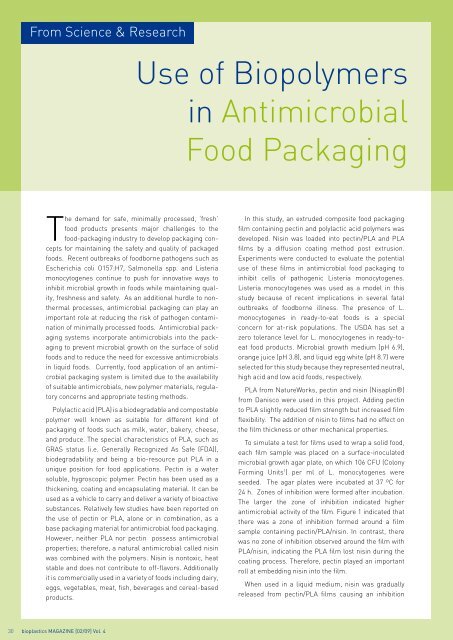bioplasticsMAGAZINE_0902
bioplasticsMAGAZINE_0902
bioplasticsMAGAZINE_0902
You also want an ePaper? Increase the reach of your titles
YUMPU automatically turns print PDFs into web optimized ePapers that Google loves.
From Science & Research<br />
Use of Biopolymers<br />
in Antimicrobial<br />
Food Packaging<br />
The demand for safe, minimally processed, ‘fresh’<br />
food products presents major challenges to the<br />
food-packaging industry to develop packaging concepts<br />
for maintaining the safety and quality of packaged<br />
foods. Recent outbreaks of foodborne pathogens such as<br />
Escherichia coli O157:H7, Salmonella spp. and Listeria<br />
monocytogenes continue to push for innovative ways to<br />
inhibit microbial growth in foods while maintaining quality,<br />
freshness and safety. As an additional hurdle to nonthermal<br />
processes, antimicrobial packaging can play an<br />
important role at reducing the risk of pathogen contamination<br />
of minimally processed foods. Antimicrobial packaging<br />
systems incorporate antimicrobials into the packaging<br />
to prevent microbial growth on the surface of solid<br />
foods and to reduce the need for excessive antimicrobials<br />
in liquid foods. Currently, food application of an antimicrobial<br />
packaging system is limited due to the availability<br />
of suitable antimicrobials, new polymer materials, regulatory<br />
concerns and appropriate testing methods.<br />
Polylactic acid (PLA) is a biodegradable and compostable<br />
polymer well known as suitable for different kind of<br />
packaging of foods such as milk, water, bakery, cheese,<br />
and produce. The special characteristics of PLA, such as<br />
GRAS status (i.e. Generally Recognized As Safe (FDA)),<br />
biodegradability and being a bio-resource put PLA in a<br />
unique position for food applications. Pectin is a water<br />
soluble, hygroscopic polymer. Pectin has been used as a<br />
thickening, coating and encapsulating material. It can be<br />
used as a vehicle to carry and deliver a variety of bioactive<br />
substances. Relatively few studies have been reported on<br />
the use of pectin or PLA, alone or in combination, as a<br />
base packaging material for antimicrobial food packaging.<br />
However, neither PLA nor pectin possess antimicrobial<br />
properties; therefore, a natural antimicrobial called nisin<br />
was combined with the polymers. Nisin is nontoxic, heat<br />
stable and does not contribute to off-flavors. Additionally<br />
it is commercially used in a variety of foods including dairy,<br />
eggs, vegetables, meat, fish, beverages and cereal-based<br />
products.<br />
In this study, an extruded composite food packaging<br />
film containing pectin and polylactic acid polymers was<br />
developed. Nisin was loaded into pectin/PLA and PLA<br />
films by a diffusion coating method post extrusion.<br />
Experiments were conducted to evaluate the potential<br />
use of these films in antimicrobial food packaging to<br />
inhibit cells of pathogenic Listeria monocytogenes.<br />
Listeria monocytogenes was used as a model in this<br />
study because of recent implications in several fatal<br />
outbreaks of foodborne illness. The presence of L.<br />
monocytogenes in ready-to-eat foods is a special<br />
concern for at-risk populations. The USDA has set a<br />
zero tolerance level for L. monocytogenes in ready-toeat<br />
food products. Microbial growth medium (pH 6.9),<br />
orange juice (pH 3.8), and liquid egg white (pH 8.7) were<br />
selected for this study because they represented neutral,<br />
high acid and low acid foods, respectively.<br />
PLA from NatureWorks, pectin and nisin (Nisaplin®)<br />
from Danisco were used in this project. Adding pectin<br />
to PLA slightly reduced film strength but increased film<br />
flexibility. The addition of nisin to films had no effect on<br />
the film thickness or other mechanical properties.<br />
To simulate a test for films used to wrap a solid food,<br />
each film sample was placed on a surface-inoculated<br />
microbial growth agar plate, on which 106 CFU (Colony<br />
Forming Units 1 ) per ml of L. monocytogenes were<br />
seeded. The agar plates were incubated at 37 ºC for<br />
24 h. Zones of inhibition were formed after incubation.<br />
The larger the zone of inhibition indicated higher<br />
antimicrobial activity of the film. Figure 1 indicated that<br />
there was a zone of inhibition formed around a film<br />
sample containing pectin/PLA/nisin. In contrast, there<br />
was no zone of inhibition observed around the film with<br />
PLA/nisin, indicating the PLA film lost nisin during the<br />
coating process. Therefore, pectin played an important<br />
roll at embedding nisin into the film.<br />
When used in a liquid medium, nisin was gradually<br />
released from pectin/PLA films causing an inhibition<br />
30 bioplastics MAGAZINE [02/09] Vol. 4


















